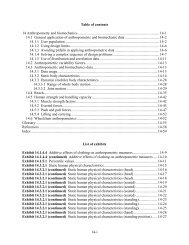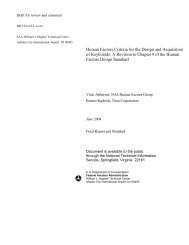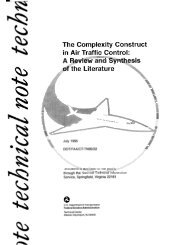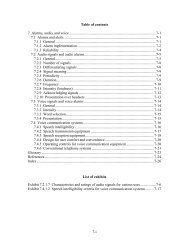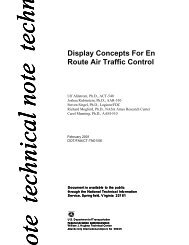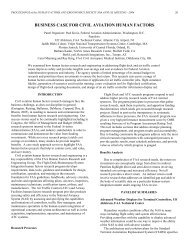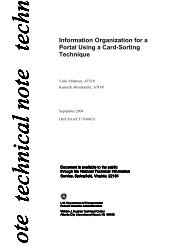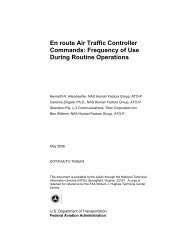Design of information Display Systems for Air Traffic Control - FAA
Design of information Display Systems for Air Traffic Control - FAA
Design of information Display Systems for Air Traffic Control - FAA
Create successful ePaper yourself
Turn your PDF publications into a flip-book with our unique Google optimized e-Paper software.
Some <strong>of</strong> the IDSs in the field used touch screen displays. There are both advantages and<br />
disadvantages to using these displays. One advantage is that they are a fast way <strong>for</strong> the user to<br />
navigate through a system (HF-STD-001, Exhibit 9.0). Touch screens provide a more direct<br />
<strong>for</strong>m <strong>of</strong> interaction than pointing devices. When using a pointing device such as a mouse, users<br />
must coordinate the position in xy space on a mouse pad with the position in xy space on the<br />
screen. With a touch panel, they are dealing with only one two-dimensional Cartesian space. A<br />
disadvantage <strong>of</strong> touch screens is that they sometimes have low touch resolution (HF-STD-001,<br />
Exhibit 9.0). That is, if the user has a large finger and is trying to activate a single button in a set<br />
<strong>of</strong> buttons placed close to one another, it is easy <strong>for</strong> the user to accidentally press the wrong<br />
button. Other problems that have been associated with the use <strong>of</strong> touch screens include (a) users<br />
blocking <strong>in<strong>for</strong>mation</strong> on the screen with their finger, (b) poor visibility due to finger prints on the<br />
display, and (c) arm fatigue after extended use (HF-STD-001, Exhibit 9.0).<br />
In the field, the most commonly reported problems with the use <strong>of</strong> touch screens were<br />
misalignment or sensitivity <strong>of</strong> displays and difficulty with manipulating small objects. The<br />
misalignment and sensitivity issues are hardware problems that cause the system to activate the<br />
object next to the one the user touches or make it difficult to activate an object. When an<br />
alternative input device was not available, the Specialists reported becoming frustrated with<br />
having to per<strong>for</strong>m repeated actions to get the system to respond. The difficulty with small<br />
objects, such as toolbar buttons, is that people’s fingers are too big to activate and deactivate<br />
them precisely.<br />
The touch screens we observed in the field were typically placed within reach <strong>of</strong> the Specialists<br />
or on an articulating arm that allowed the Specialists to pull the display closer or push it out <strong>of</strong><br />
the way. Placement is a consideration with any type <strong>of</strong> display, but a particularly important one<br />
with touch screen displays. All users, regardless <strong>of</strong> their height or whether they are left or righthanded,<br />
must be able to see and touch the display from their normal working position. Based on<br />
our observations, the articulating arm was a good solution to this problem.<br />
Input devices are also an important consideration <strong>for</strong> an IDS. Our findings show that even with<br />
touch screen displays, an effective input device can facilitate the user’s interaction with the<br />
system. Based on their reports, touch screen users <strong>of</strong>ten preferred using a trackball over their<br />
finger or a stylus. In the ATC environment the workstations typically have little desk space,<br />
making trackballs the preferred device. Specific guidelines <strong>for</strong> non-keyboard input devices are<br />
available in Ahlstrom and Kudrick (2004).<br />
Finally, display characteristics should be considered. The same amount <strong>of</strong> <strong>in<strong>for</strong>mation</strong> can<br />
appear cluttered on a small display and well spaced on a large display. The many pieces <strong>of</strong><br />
<strong>in<strong>for</strong>mation</strong> that may be presented on an IDS call <strong>for</strong> a display that is large enough to effectively<br />
present the required <strong>in<strong>for</strong>mation</strong> and still be accommodated in the workstation. A larger display<br />
will also enable the user to make effective use <strong>of</strong> capabilities such as manipulating graphics and<br />
displaying multiple windows. <strong>Display</strong> resolution, brightness, and contrast should be adequate<br />
<strong>for</strong> viewing under operational conditions. To accommodate the users’ individual preferences <strong>for</strong><br />
display brightness, the brightness and contrast should be adjustable.<br />
22



